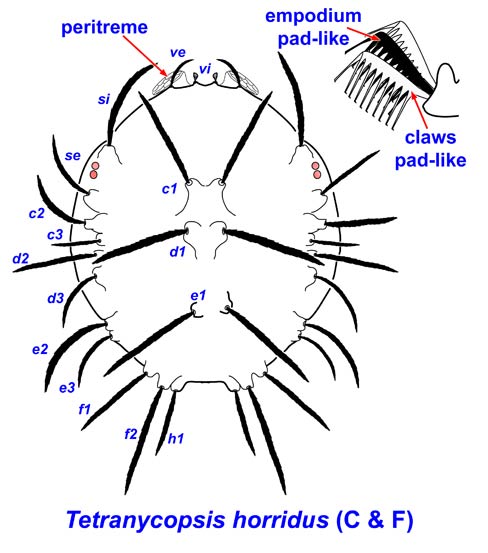Tetranycopsis
Superfamily Tetranychoidea
Family Tetranychidae
Subfamily Bryobiinae
Tribe Hystrichonychini
Genus Tetranycopsis
Common names: clover mites
Probability of Encounter: Medium.
Quarantine importance: Medium. The genus Tetranycopsis has few economically important pests. Fewer than 10 species are described and most do not infest agricultural crops.
-
T. zambezianus feeds on soybean and cotton in parts of southern Africa and Madagascar.
-
The hazelnut mite T. horridus (C&F) is a pest of filberts in Europe, Asia, and Oregon and also feeds on yarrow, walnut, spruce, pine, red cedar, and beans.
 Diagnosis:
Diagnosis:
-
Claws and empodium pad-like.
-
Prodorsum with 4 pairs of setae (vi, ve, sci, sce); without prominent lobes over the gnathosoma.
-
Opisthosoma with 12 pairs of setae (c1-3, d1-3, e1-3, f1-2, h1.
Similar taxa. The true spider mites in the Tetranychinae do not have empodia with tenent hairs. Either the claws or the empodia are hooked in other tribes of Bryobiinae.
References
Baker EW & AE Pritchard. 1960. The tetranychoid mites of Africa. Hilgardia 29(11): 455-574.
Baker EW & DM Tuttle. 1994. A guide to the spider mites (Tetranychidae) of the United States. Indira Pub. House, West Bloomfield, MI: 347 pp.
Bolland HR 2001. Mites (Acari: Tetranychidae and Phytoseiidae) from the Tatra Mountains in Slovakia, with special remarks on Tetranycopsis hystriciformis Reck. Intern. J. Acarol. 27(3): 225-227.
Bolland HR, J Gutierre & CHW Flechtmann. 1998. World Catalogue of the Spider Mite Family (Acari: Tetranychidae). Brill: Leiden.
Helle W & MW Sabelis (eds.) 1985. Spider Mites, Their Biology, Natural Enemies, and Control, vol. 1A. Elsevier: New York.
Jeppson LR, HH Keifer & EW Baker. 1975. Mites Injurious to Economic Plants, University of California Press: Berkeley.